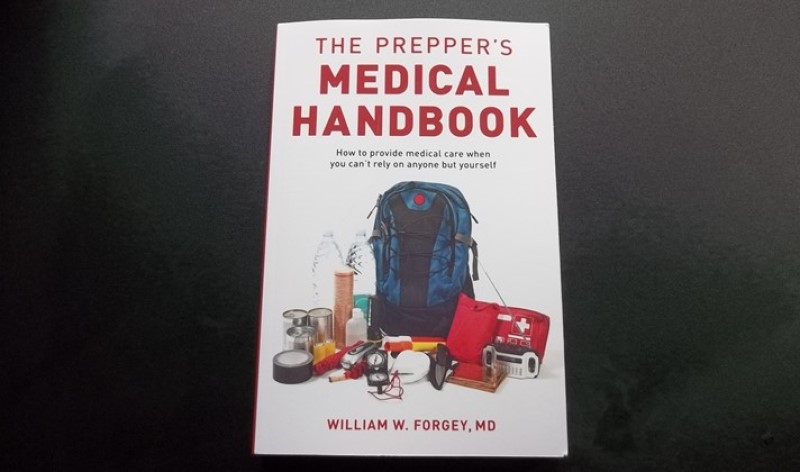Disclaimer: A few weeks ago I was sent the Kindle version of The Prepper’s Medical Handbook by the author in exchange for an honest review, and I’m thankful to Dr. Forgey for the opportunity.
For starters, I actually own more than one copy of his excellent Wilderness Medicine: Beyond First Aid book (they’re older editions, though) which I keep as part of my ever-expanding off-grid book collection. And I’m glad to add yet another excellent reference as I purchased the paperback edition over the weekend.
Now, I’ll let you in on a little secret: I’ve become a bit of a germophobe in recent years, and the current pandemic hasn’t helped. Plus, after reading through The Prepper’s Medical Handbook I’m almost positive I have a few dozen new diseases. Of course, I’m only joking about that.
My issues aside, I found myself willfully reading through the book more and more over the past week. Truth be told, I’d planned to only skim the book because I tend to find that medical books are tedious and boring.
Not this one.
I actually found many surprising tidbits of information that could prove useful. For example, when further assessing a patient, he recommends: “This methodical examination should generally start at the head and work its way to the feet. The exception could be children, where you might want to alleviate their apprehension by starting with their legs before examining their heads. Generally starting at the head is best.” That makes sense now, and I would’ve had no idea otherwise. Dr. Forgey then explains why the Romani culture would find it insulting to be touched below the waist before being touched above. Who knew?
As another example, later on he explains why people should breathe into a paper bag when hyperventilating like we all see in the movies: “It would be helpful for victims to rebreathe their air from a stuff sack to increase the carbon dioxide level in the bloodstream.” Again, I thought this was just to limit their air intake capacity; I had no idea it was to increase CO2 levels. The book is littered with useful facts like this.
You might even appreciate his sense of humor that I noticed on occasion: “Oral thermometers will give the most accurate field temperatures unless the ambient temperature is close to the room temperature of a Ritz-Carlton resort, in which case forehead infrared or ear temperature thermometers are convenient, until their batteries wear out.” The Ritz-Carlton would be the way to survive!
Interesting facts and humor aside, Dr. Forgey does an excellent job of explaining a wide variety of medical concerns from a prepper’s perspective which is, after all, the entire point in the book. This is something that I greatly appreciate since almost all first aid books expect you to stabilize the patient and then call 9-1-1. Clearly that’s not possible in a SHTF (or TEOTWAWKI as the author puts it) situation. We need more advice than that and the book delivers.
So, what’s inside the book?
Roughly the first third of the book–the first three chapters, in fact–is dedicated to patient assessment and dealing with all of the many maladies one might possibly encounter from head to toe, generally sorted by body part, from major problems like breathing issues and infections to nosebleeds and itchy skin… and everything in between. Most sections are short enough to read through quickly, yet detailed enough to tell you precisely what needs to be done. It doesn’t get much better than that from a layman’s perspective.
Interestingly, the very next chapter delves into nuclear radiation which comes before chapters on dental care, wound treatment (such as major bleeding), and joint pain or injury (e.g., fractures and strains), to name a few. Personally, I would think that information regarding bleeding to death is more crucial to know considering how much more likely they are to occur in a typical disaster. My guess is the good doctor is highly concerned about an EMP or worse where he lives, what do you think? No matter. It’s a relatively short chapter on radiation and everything else that I consider more important is covered eventually.
I won’t bore you with detailing each specific chapter, suffice it to say that almost everything I expected to see was covered and then some with the exception of children. While differences in treating children were pointed out as necessary, such as how much of a medication to give them if it differs from an adult dosage, I would’ve appreciated a specific chapter discussing their particular problems and needs. The same can be said for properly dealing with something like pregnancy and childbirth because, you know, that stuff is going to happen given enough time. In fairness, I don’t recall my other medical handbooks specifically discussing children in any length.
Of particular interest to me was the chapter on Bioterrorism and Infectious Disease. Although the author discusses a plethora of diseases–generally explaining what to look for as well as treatment protocol–I didn’t see anything relating to pandemics or self-quarantine, which was surprising. I surely would’ve appreciated the doctor’s take on the subject given our current circumstances. That said, I think we all know what to do now, so much so that each of us could write a book on the topic of pandemic preparedness, lol.
Aside from a few minor preferences that I would’ve liked to see, this book is truly a must-have for those of us interested in any sort of lengthy off-grid survival, even including an entire chapter on creating a comprehensive medical kit. You will be glad you have it in-hand when the time comes. The Prepper’s Medical Handbook by Dr. Forgey is clearly well-written, truly informative, and condenses decades of knowledge into an easily referenced resource we should all have in our SHTF library. Do yourself a favor and grab a copy today.

Leave a Reply